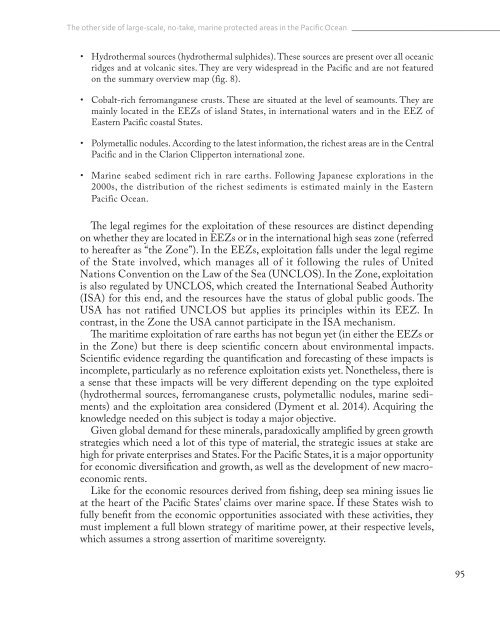Fisheries in the Pacific
Fisheries_in_the_Pacific
Fisheries_in_the_Pacific
Create successful ePaper yourself
Turn your PDF publications into a flip-book with our unique Google optimized e-Paper software.
The o<strong>the</strong>r side of large-scale, no-take, mar<strong>in</strong>e protected areas <strong>in</strong> <strong>the</strong> <strong>Pacific</strong> Ocean<br />
• Hydro<strong>the</strong>rmal sources (hydro<strong>the</strong>rmal sulphides). These sources are present over all oceanic<br />
ridges and at volcanic sites. They are very widespread <strong>in</strong> <strong>the</strong> <strong>Pacific</strong> and are not featured<br />
on <strong>the</strong> summary overview map (fig. 8).<br />
• Cobalt-rich ferromanganese crusts. These are situated at <strong>the</strong> level of seamounts. They are<br />
ma<strong>in</strong>ly located <strong>in</strong> <strong>the</strong> EEZs of island States, <strong>in</strong> <strong>in</strong>ternational waters and <strong>in</strong> <strong>the</strong> EEZ of<br />
Eastern <strong>Pacific</strong> coastal States.<br />
• Polymetallic nodules. Accord<strong>in</strong>g to <strong>the</strong> latest <strong>in</strong>formation, <strong>the</strong> richest areas are <strong>in</strong> <strong>the</strong> Central<br />
<strong>Pacific</strong> and <strong>in</strong> <strong>the</strong> Clarion Clipperton <strong>in</strong>ternational zone.<br />
• Mar<strong>in</strong>e seabed sediment rich <strong>in</strong> rare earths. Follow<strong>in</strong>g Japanese explorations <strong>in</strong> <strong>the</strong><br />
2000s, <strong>the</strong> distribution of <strong>the</strong> richest sediments is estimated ma<strong>in</strong>ly <strong>in</strong> <strong>the</strong> Eastern<br />
<strong>Pacific</strong> Ocean.<br />
The legal regimes for <strong>the</strong> exploitation of <strong>the</strong>se resources are dist<strong>in</strong>ct depend<strong>in</strong>g<br />
on whe<strong>the</strong>r <strong>the</strong>y are located <strong>in</strong> EEZs or <strong>in</strong> <strong>the</strong> <strong>in</strong>ternational high seas zone (referred<br />
to hereafter as “<strong>the</strong> Zone”). In <strong>the</strong> EEZs, exploitation falls under <strong>the</strong> legal regime<br />
of <strong>the</strong> State <strong>in</strong>volved, which manages all of it follow<strong>in</strong>g <strong>the</strong> rules of United<br />
Nations Convention on <strong>the</strong> Law of <strong>the</strong> Sea (UNCLOS). In <strong>the</strong> Zone, exploitation<br />
is also regulated by UNCLOS, which created <strong>the</strong> International Seabed Authority<br />
(ISA) for this end, and <strong>the</strong> resources have <strong>the</strong> status of global public goods. The<br />
USA has not ratified UNCLOS but applies its pr<strong>in</strong>ciples with<strong>in</strong> its EEZ. In<br />
contrast, <strong>in</strong> <strong>the</strong> Zone <strong>the</strong> USA cannot participate <strong>in</strong> <strong>the</strong> ISA mechanism.<br />
The maritime exploitation of rare earths has not begun yet (<strong>in</strong> ei<strong>the</strong>r <strong>the</strong> EEZs or<br />
<strong>in</strong> <strong>the</strong> Zone) but <strong>the</strong>re is deep scientific concern about environmental impacts.<br />
Scientific evidence regard<strong>in</strong>g <strong>the</strong> quantification and forecast<strong>in</strong>g of <strong>the</strong>se impacts is<br />
<strong>in</strong>complete, particularly as no reference exploitation exists yet. None<strong>the</strong>less, <strong>the</strong>re is<br />
a sense that <strong>the</strong>se impacts will be very different depend<strong>in</strong>g on <strong>the</strong> type exploited<br />
(hydro<strong>the</strong>rmal sources, ferromanganese crusts, polymetallic nodules, mar<strong>in</strong>e sediments)<br />
and <strong>the</strong> exploitation area considered (Dyment et al. 2014). Acquir<strong>in</strong>g <strong>the</strong><br />
knowledge needed on this subject is today a major objective.<br />
Given global demand for <strong>the</strong>se m<strong>in</strong>erals, paradoxically amplified by green growth<br />
strategies which need a lot of this type of material, <strong>the</strong> strategic issues at stake are<br />
high for private enterprises and States. For <strong>the</strong> <strong>Pacific</strong> States, it is a major opportunity<br />
for economic diversification and growth, as well as <strong>the</strong> development of new macroeconomic<br />
rents.<br />
Like for <strong>the</strong> economic resources derived from fish<strong>in</strong>g, deep sea m<strong>in</strong><strong>in</strong>g issues lie<br />
at <strong>the</strong> heart of <strong>the</strong> <strong>Pacific</strong> States’ claims over mar<strong>in</strong>e space. If <strong>the</strong>se States wish to<br />
fully benefit from <strong>the</strong> economic opportunities associated with <strong>the</strong>se activities, <strong>the</strong>y<br />
must implement a full blown strategy of maritime power, at <strong>the</strong>ir respective levels,<br />
which assumes a strong assertion of maritime sovereignty.<br />
95


